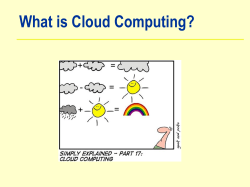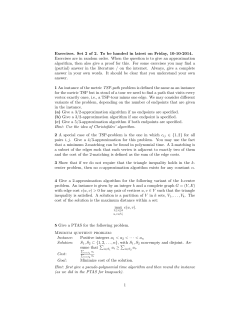
Maestro CLI Quick Start User Guide EPAM Cloud Orchestrator
EPAM Cloud Orchestrator Maestro CLI Quick Start User Guide November 2014 CIUG-2 Version 2.1 Content Preface ............................................................................................................... 3 About this Guide ........................................................................................................... 3 Audience ............................................................................................................... 3 The structure of the Guide ............................................................................................ 3 Documentation References .......................................................................................... 4 1. Prerequisites ............................................................................................................... 5 2. Procedure ............................................................................................................... 6 2.1. Setting Access Credentials .................................................................... 6 2.2. Determining Available Shapes .............................................................. 7 2.3. Determining Available Machine Images ................................................ 8 2.4. Running Instances ................................................................................. 9 2.5. Viewing Instance Properties ................................................................ 10 2.6. Logging in to Instances ........................................................................ 11 2.7. Terminating an Instance ...................................................................... 12 Table of Figures .................................................................................................................... 13 Version history ...................................................................................................................... 13 EPAM CONFIDENTIAL 2 Preface About this Guide Maestro Command Line Interface (CLI) is a REST client for EPAM Cloud Orchestrator. It is intended to perform Orchestrator commands via remote command line by sending server API requests using REST API without the need to install any 3rd party utilities (e.g. cURL, Poster). The quick start guide is intended to show you a common use case of cloud environment setup by means of detailed step-by-step configuration description Audience This guide is designed for EPAM Private Cloud users who manage their own infrastructure via Maestro CLI. The structure of the Guide The guide consists of two sections: 1. Prerequisites. This section gives the list of the prerequisites that are to be met for Maestro CLI to perform successfully. 2. Procedure. This section gives detailed instructions and useful tips on different stages and actions that can be performed via Maestro CLI. The section covers basic operations on instances creation and manipulation as well as the ways to log in to them. 3 EPAM CONFIDENTIAL EPAM Cloud Orchestrator - Maestro CLI - Quick Start Guide Documentation References You might also want to check the following EPAM Cloud Orchestrator documents: Document Title Contains Information on Maestro CLI Developer Guide Maestro CLI Setup Guide Maestro CLI client use and customization Installation of Maestro CLI Client Maestro CLI Quick Start Guide Setting up a common cloud environment Auto Configuration: Box Solutions Auto Configuration Service concept and usage Maestro CLI Reference Guide EPAM Cloud Orchestrator Command Line Interface and the list of CLI commands, their parameters and response examples Maestro API Reference Guide EPAM Cloud Orchestrator Application Programming Interface Project Management Guide Hints and guidelines on customization of EPAM Orchestrator for the specific project needs Resource Utilization Quotas Guide Checkpoint Utilization Guide Email Notification Subscriptions Guide EPAM Private Cloud Billing Guide Resource Utilization Quotas and respective guidelines Concepts of checkpoints, including their utilization within Orchestrator, limitations and best practices Notifications description, usage and customization guidelines and default values Current billing model implemented for EPAM Private Cloud Graphical User Interface Guide Setup and utilization of Amazon Web Services-based infrastructure through EPAM Cloud Orchestrator EPAM Cloud Orchestration graphical user interface Maestro Stacks Guide Maestro Stacks creation and utilization Maestro CLI Quick Reference Card A set of all CLI commands AWS Utilization Guide Please email your comments and feedback to EPAM Cloud Consulting at SpecialEPM-CITConsulting@epam.com to help us provide you with documentation that is as clear, correct and readable as possible. 4 EPAM SYSTEMS 1. Prerequisites NB: Meeting the following prerequisites is a must. Otherwise, Maestro CLI will not function properly. Before you proceed with this guide, make sure to do the following: - Install Java 1.6 or Java 1.7 Perform Express installation of the CLI client. See ‘EPAM Cloud Orchestrator - Maestro CLI - Setup’ guide for detailed guidelines. - Make sure you have valid PMC credentials (user ID, password). - Check whether your PMC project is activated in EPAM Cloud and which virtualization regions are available for it. You can do it in one step by invoking the or2-describe-regions(or2dreg) command. If your project is active, you will get a list of available regions. An example output is given in the screenshot below: Figure 1 – or2-describe-regions response for an active project The list of the regions may depend on your current project role. If the specified project is not activated, you will get the following CLI output: Figure 2 – or2-describe-regions response for an inactive project - 5 If the project is not activated, please contact the Help Desk to activate it. The project activation should be approved by the project manager or coordinator. Obtain an SSH client application (PuTTY or similar). EPAM CONFIDENTIAL EPAM Cloud Orchestrator - Maestro CLI - Quick Start Guide 2. Procedure By following the steps from this section, you will be able to quickly launch, configure and then terminate a virtual Machine (Instance) in EPAM Private Cloud by means of Maestro CLI commands. NB: Each Maestro CLI command has two invoke options: its default name and shortened one. Choosing an option to use is up to you. Shortened names are hereinafter provided in brackets after each full command name. 2.1. Setting Access Credentials NB: This document contains command examples using Windows 7 syntax. In case you use a *nix OS, make sure to either add the ‘./’ prefix to each command or configure an environment variable pointing at Maestro-CLI directory. In case you did not do it earlier, run the or2-get-access (or2access) command and enter your credentials when prompted. You can choose, whether to use your EPAM PMC (without ‘@epam.com’) or Domain (with ‘@epam.com’) credentials. If successful, the ‘default.cr’ file will be created, and you will no longer need to provide your user credentials. You can run this command and provide the ‘-s’ parameter to use your system credentials. If this parameter is skipped, the command requests PMC or EPAM domain credentials. Command example: or2-get-access Response example: The command returns user name and encoded password. Figure 3 - or2-get-access Response Example EPAM CONFIDENTIAL 6 2.2. Determining Available Shapes Run or2-describe-shapes (or2dshape) command to find out available instance shapes for your PMC project. Provide your PMC project ID (-p) and service region (-r) as its parameters. Command example: or2-describe-shapes -p epm-cit -r EPAM-MSQ Response example: The command returns a list of available shapes with their names (left column), number of CPU’s (middle column) and available RAM (right column) per shape. Figure 4 - or2dshape Response Example See ‘EPAM Cloud Orchestrator - Maestro CLI - User/Reference Guide’ for detailed Maestro CLI command reference. 7 EPAM CONFIDENTIAL EPAM Cloud Orchestrator - Maestro CLI - Quick Start Guide 2.3. Determining Available Machine Images Run or2-describe-images (or2dim) command to find out available machine images for your project and virtualization region. Provide your PMC project ID (-p) and virtualization region (-r) as its parameters. Command example: or2-describe-images -p epm-pmc -r epam-msq Response example: The command returns a list of available machine images IDs with their description and additional info (group and state) Figure 5 - or2dshape Response Example 8 EPAM SYSTEMS 2.4. Running Instances Choose a shape and a machine image among the available ones (See steps 2.2 Determining Available Shapes and 2.3 - Determining Available Machine Images.) Run or2-run-instances (or2run) command to launch your instance. Provide your PMC project ID (-p), virtualization region (-r), required shape (-s), required machine image (-i), and required number of instances (-c) (optional) as its parameters. You can also provide the expiration date parameter (-e) as ‘yyyy-MM-ddTHH:mm’ (ISO 8601) EPAM Cloud Orchestrator will stop the instance at the specified time. If you use keypairs, submit the name of existing keypair to associate with this instance via the (-k) parameter NB: The ‘--count’ parameter must be an integer value greater than 0. If the ‘-c’ parameter is omitted, the application regards this as ‘count=1’ and launches a single instance. Command example: or2-run-instances -p epm-cit -r epam-msq -s small -i CentOS6template -c 1 Response example: The command returns an ID assigned to your instance and its current state. Figure 6 - or2run Response Example NB: Having executed the or2-run-instances command, wait for email confirmation that your instance has launched (or failed to do so) , before running the next command. Please keep in mind that: a) b) It takes at least 25 minutes to launch a Windows VM If you send a request to create multiple instances, they will be processed one-by-one. 9 EPAM CONFIDENTIAL EPAM Cloud Orchestrator - Maestro CLI - Quick Start Guide 2.5. Viewing Instance Properties Run or2-describe-instances (or2din) command to confirm your instance has been successfully launched and find out its IP address. Provide your PMC project ID (-p), virtualization region (-r), and instance id (-i) as its parameters. NB: To see a list of all instances running in your virtualization region for your project, do not include the ‘-i’ parameter. Command example: or2-describe-instances -p epm-cit -r epam-msq -i %INSTANCE_ID% Response example: The command returns the following information concerning your instance (left to right): ID, DNS name, private IP, current state, number of CPUs, amount of RAM, operating system. Figure 7 - or2din Response Example 10 EPAM SYSTEMS 2.6. Logging in to Instances Run your SSH client and connect to your instance, specifying its private IP (See step 2.5 Viewing Instance Properties.) NB: In order to access Windows instances via SSH you first have to access them via RDP and configure SSH connection. Figure 8 - Connecting to an Instance via SSH Once you login to your instance login using your EPAM domain credentials (for Windowsbased instances) or default credentials: login:user/password:user (for *nix-based instances). In the latter case you will have to change the default credentials before you continue working with your instance. 11 EPAM CONFIDENTIAL EPAM Cloud Orchestrator - Maestro CLI - Quick Start Guide 2.7. Terminating an Instance Once you no longer need your instance, run or2-terminate-instances (or2kill) command to terminate it. Provide your PMC project ID (-p), virtualization region (-r), and instance id (-i) as its parameters. Having executed this command you should type ‘yes’ as confirmation, when prompted. You can skip this step and proceed with termination by providing the (-y) parameter initially. Please, exercise caution when using it to avoid unintentional instance termination. NB: If you would like to save attached storages, make sure you also include the ‘-l’ parameter (without quotes). The default command behavior is deleting attached storage volumes as well. Command example: or2-terminate-instances -p epm-cit -r epam-msq -i %INSTANCE_ID% Response example: The command returns your instance ID (left column) and its current state (right column) Figure 9 - or2kill Response Example 12 EPAM SYSTEMS Table of Figures Figure 1 - or2-get-access Response Example ....................................................................... 6 Figure 2 - or2dshape Response Example .............................................................................. 7 Figure 3 - or2dshape Response Example .............................................................................. 8 Figure 4 - or2run Response Example ..................................................................................... 9 Figure 5 - or2din Response Example ................................................................................... 10 Figure 6 - Connecting to an Instance via SSH ...................................................................... 11 Figure 7 - or2kill Response Example ................................................................................... 12 Version history Version Summary 1.0 October 29, 2012 Initial version is published 1.1 November 15, 2012 Command syntax is brought up to date 1.2 December 21, 2012 Screenshots are updated 1.3 January 8, 2013 2.0 13 Date - Warnings and screenshots are updated Typos are fixed - or2access, or2dshape, or2dim, and or2kill commands description is updated - Minor omissions are fixed April 11, 2013 2.01 August 16, 2013 - Related documents are added 2.02 August 30, 2013 - Links throughout the document are updated 2.03 November 28, 2013 - Preface is added - Documentation links updated 2.04 September 20, 2014 - Java versions added 2.1 November 1, 2014 - Documentation references updated EPAM CONFIDENTIAL Global 41 University Drive Suite 202, Newtown (PA), 18940, USA Phone: +1-267-759-9000 Fax: +1-267-759-8989 EU Corvin Offices I. Futó st 4753 Budapest, H-1082, Hungary Phone: Fax: +36-1-327-7400 +36-1-577-2384 CIS 9th Radialnaya Building 2 Street, Moscow, 115404, Russia Phone: +7-495-730-6360 Fax: +7-495-730-6361 © 1993-2012 EPAM Systems. All Rights Reserved.
© Copyright 2025










